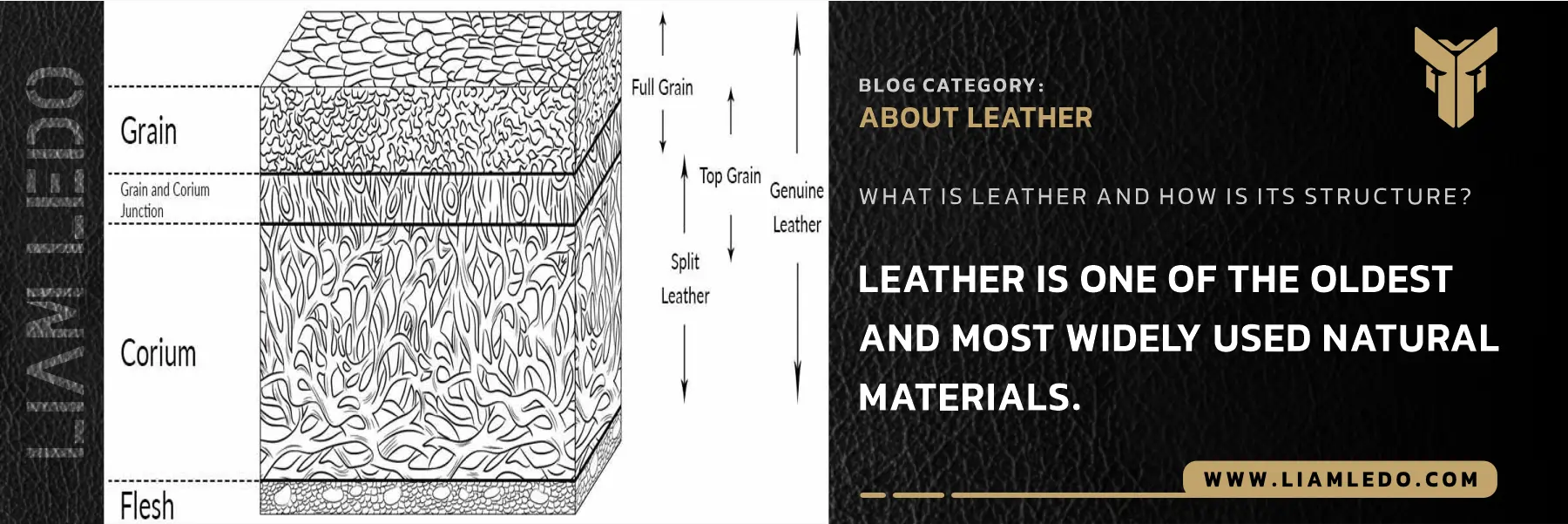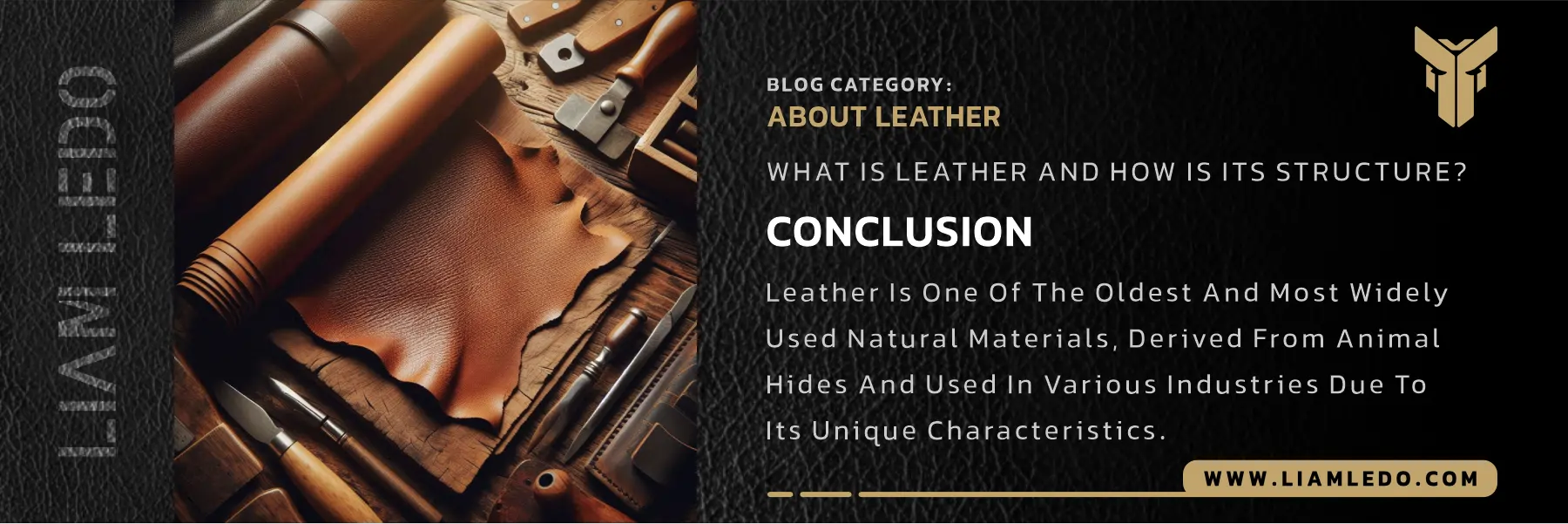Leather Structure Layers: Understanding the Physical and Chemical Composition of Leather

Leather is one of the most durable and widely used natural materials, appreciated for its strength, flexibility, and timeless appeal. Derived from animal hides, leather has been used by humans for thousands of years in clothing, accessories, furniture, and industrial applications. In this article, we’ll explore the definition of leather, its production process, and most importantly, the leather structure layers that give it its unique qualities. Understanding these layers helps consumers and craftsmen recognize the value, performance, and applications of different types of leather.
Learn more about leather and make better choices:
Definition of Leather:
Leather is a processed natural material obtained from the hides of animals, primarily cattle, goats, pigs, and sheep. The transformation of raw hides into usable leather involves a process called tanning, which preserves the collagen structure and prevents the material from decomposing. Leather’s composition and strength stem from the physical and chemical structure of the skin, which includes specific layers and proteins.
Brief History of Leather:
The use of leather dates back to prehistoric times, when early humans used raw animal hides for protection and insulation. As civilizations developed, so did the techniques of tanning. Ancient Egyptians, Greeks, and Mesopotamians considered leather a valuable material for clothing, armor, and household goods. Today, technological advancements have improved both the quality and sustainability of leather production, leading to diverse applications across fashion, automotive, and industrial sectors.

Leather Production Process:
Producing high-quality leather involves several meticulous steps, each designed to clean, treat, and preserve the hide while enhancing its durability and appearance. Here is an overview of the typical leather production stages:
- Hide Preparation: Fresh hides are collected and cleaned of excess flesh, fat, and hair.
- Soaking: The hides are soaked in water to remove dirt, blood, and salts while restoring moisture.
- Liming: Hides are treated with lime to loosen the hair and open the fiber structure, preparing the skin for tanning.
- Tanning: In this crucial step, hides are stabilized using chemical (e.g., chromium salts) or natural (e.g., vegetable tannins) agents. Tanning strengthens the collagen network and prevents putrefaction.
- Dyeing and Finishing: After tanning, the leather is dyed, dried, conditioned, and sometimes coated, depending on the desired finish and use.
Its wide application range is a testament to its affordability and aesthetic flexibility.
Leather Structure Layers: Understanding the Physical Composition
Leather Structure Layers: Understanding the Physical Composition
To fully understand what makes leather strong, flexible, and long-lasting, we must look at its physical structure—the specific leather structure layers that remain after tanning. The original animal skin is composed of three main layers, each with its own function and characteristics. These layers include:
- Epidermis Layer:
The epidermis is the outermost layer of the skin, consisting mainly of dead skin cells. This thin layer is typically removed during tanning, as it does not contribute to the durability or flexibility of finished leather. If any remnants of the epidermis remain due to improper processing, the leather may develop an unpleasant odor or poor texture. However, the presence or absence of scent is not a reliable indicator of authenticity. - Dermis Layer (Corium):
The dermis is the thickest and most important layer in leather production. This layer contains dense networks of collagen fibers, which are arranged in a unique interwoven structure that provides both strength and elasticity. This collagen fibril orientation is essential in determining the leather’s flexibility, tensile strength, and resistance to wear. - Hypodermis Layer:
Beneath the dermis lies the hypodermis, a fatty layer that also contains connective tissue. Most of this layer is removed during processing to ensure a smoother, more durable final product. However, traces of fats and oils from the hypodermis may remain and play a role in the leather’s texture and water resistance.
Chemical Composition of Leather:
The chemical structure of leather is primarily built around collagen, a protein found in the dermal layer of animal skin. Collagen molecules are composed of three intertwined polypeptide chains forming a triple-helix structure. This triple helix of glycine–proline–hydroxyproline is what gives leather its incredible resilience and elasticity.
Other important chemical components in leather include:
- Water: Freshly tanned leather can contain up to 60% water, which contributes to its flexibility. This amount varies depending on the leather type and environmental conditions.
- Fats and Oils: Residual fats help with water resistance and give leather its softness.
- Minerals: Trace minerals from the tanning process (such as chromium or aluminum) stabilize the collagen matrix and affect the final texture and color.
How Collagen Affects Leather Performance?
Collagen doesn’t just hold the structure together—it directly impacts how leather behaves in different conditions. The crosslinking of collagen fibers during tanning improves the leather’s ability to resist mechanical stress, stretching, and tearing. The degree of crosslinking varies based on the tanning method used; for example, chromium tanning produces tighter fiber bonds than vegetable tanning, leading to different performance profiles.
Furthermore, properties like orientation index (OI)—a measure of how aligned the collagen fibers are—can influence strength and durability. A higher orientation index generally results in stronger leather with better resistance to tearing.
Benefits of Leather Derived from Its Structure:
The unique structure of leather layers and its protein-based composition result in several advantages over synthetic alternatives:
- Exceptional durability: Leather’s fibrous structure allows it to withstand years of wear and environmental stress.
- Flexibility and comfort: Thanks to the natural arrangement of collagen, leather can mold to shapes while maintaining integrity.
- Breathability: Leather is porous, allowing air to pass through, which enhances comfort in footwear and clothing.
- Natural beauty: The grain patterns of leather, influenced by the dermis, offer a luxurious, organic appearance.
- Biodegradability: Natural leather is biodegradable, especially when processed without heavy synthetic coatings.

Final Thoughts:
Understanding the leather structure layers is essential for appreciating the durability, beauty, and performance of leather products. From the collagen-rich dermis to the chemical interactions during tanning, each stage and layer contributes to the final product’s quality. Whether used in fashion, furniture, or automotive design, leather’s physical and chemical composition makes it one of the most versatile and valued natural materials in human history.
If you’re exploring leather products—whether for fashion, design, or retail—it helps to know what lies beneath the surface. The next time you see a leather bag or jacket, remember the complex biology and careful craftsmanship that created it. This knowledge not only deepens your appreciation but also guides you in choosing quality leather with confidence.
Source: The Gentleman’s Gazette | Wikipedia







